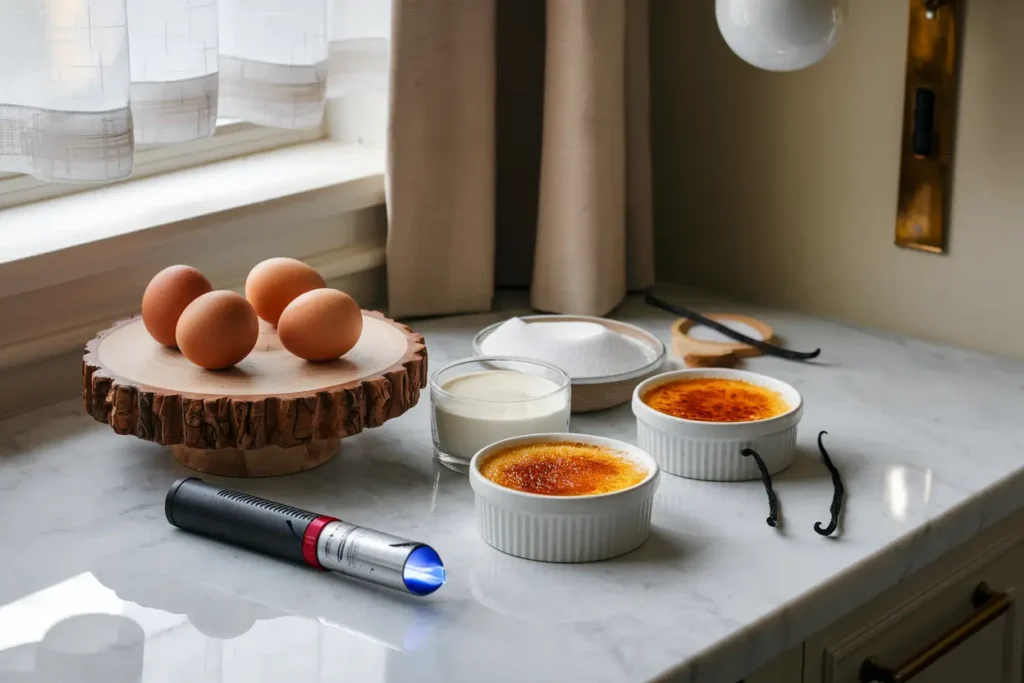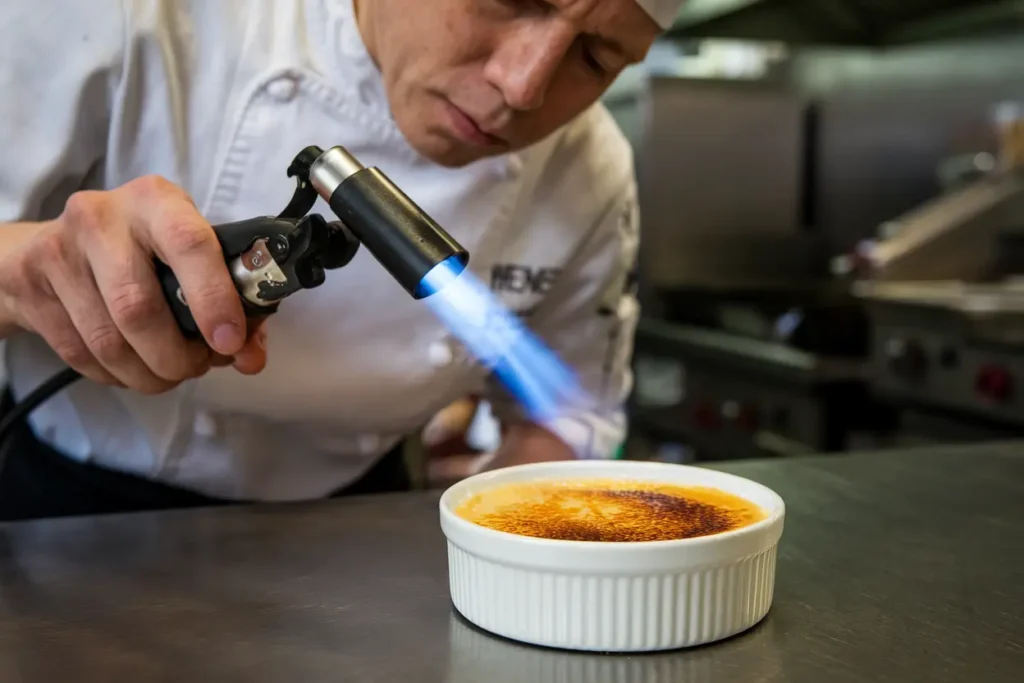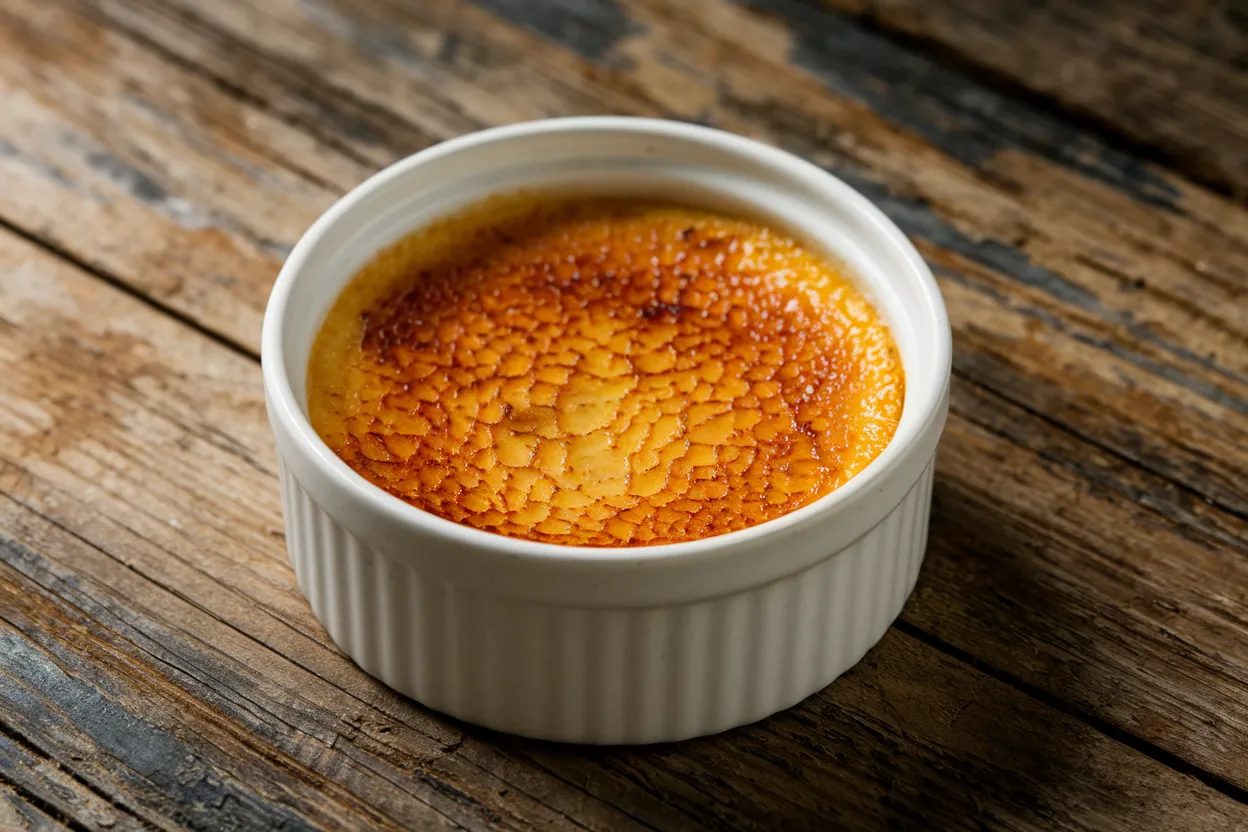Table of Contents
Crème brûlée—just saying the name can make your mouth water, right? 🍮 This timeless French dessert has captured hearts (and taste buds) all over the world with its silky custard base and irresistible caramelized sugar crust. But what exactly is the secret to crème brûlée? Is it the quality of the ingredients? The precision of the cooking process? Or maybe the iconic crack of the sugar topping when you tap your spoon?
Let’s dive deep into everything you need to know about this iconic dessert—from its fascinating history to the nitty-gritty details of perfecting it in your kitchen. Whether you’re a beginner or a seasoned chef, mastering Custard tips is within your reach.
The Perfect Ingredients for Crème Brûlée
The foundation of an excellent crème brûlée lies in using the best ingredients. Opt for heavy cream rather than milk for a richer texture. While some might wonder, “Can you use milk instead of heavy cream in crème brûlée?”, the traditional approach is to use heavy cream to ensure a velvety consistency.

When it comes to crème brûlée, simplicity is the ultimate sophistication. This dessert is proof that a few basic ingredients, when handled with care, can create something extraordinary. Let’s break down each essential component.
Choosing the Right Cream is one of Secret to Crème Brûlée
The backbone of caramelized dessert is its custard base, which starts with heavy cream. The quality of your cream matters more than you might think. Opt for full-fat heavy cream—it provides the rich and velvety texture that makes crème brûlée so indulgent. Avoid low-fat or skim options, as they lack the necessary fat content for that creamy consistency.
Pro Tip: Warm the cream before mixing it with other ingredients. This ensures a smoother custard and prevents the egg yolks from cooking unevenly during the blending process.
The Role of Egg Yolks
Egg yolks are the unsung heroes of crème brûlée. They’re what give the custard its luxurious thickness and silky texture. For best results, use fresh, high-quality eggs.
But here’s the trick: don’t overbeat the yolks. Overmixing introduces air into the custard, which can lead to an unpleasantly bubbly texture. Gently whisk them until they’re just combined.
How Sugar Impacts the Texture and Flavor
Sugar doesn’t just sweeten your dessert—it’s also a crucial player in the chemistry of crème brûlée. Fine granulated sugar blends seamlessly into the custard, while the same sugar transforms into a caramelized masterpiece when torched.
Fun Fact: The caramelized sugar topping creates a delightful contrast between the creamy custard and the crunchy shell, making every bite a sensory delight!
Infusions and Flavor Variations
Vanilla is the classic flavor for crème brûlée, but why stop there? Infusing your cream with flavors like cinnamon, citrus zest, or lavender can take your dessert to the next level. Simply steep your chosen ingredient in warm cream for 15–20 minutes, then strain it out before mixing.
Creative Twist: Try experimenting with matcha, coffee, or even a splash of liqueur like Grand Marnier or Baileys for a unique twist on the traditional recipe.
The Technique: Unlocking the Perfect Crème Brûlée
Even with the best ingredients, mastering crème brûlée comes down to technique. Here’s how to achieve custard perfection every single time.
The Importance of Low Heat Cooking
Patience is key when making caramelized dessert. Low and slow cooking ensures the custard sets without curdling or becoming grainy. Most recipes call for baking the custard at 300°F (150°C) to maintain that creamy consistency.
How to Master the Bain-Marie Method
A bain-marie—or water bath—is the secret to even cooking. By surrounding the ramekins with hot water in the oven, you prevent the custard from overheating or drying out.
Step-by-Step of the Secret to Crème Brûlée
- Place your filled ramekins in a deep baking dish.
- Pour hot water into the dish until it reaches halfway up the sides of the ramekins.
- Cover the baking dish loosely with foil to retain moisture.
This technique creates the gentle heat needed for silky-smooth custard.
Achieving the Perfect Caramelized Sugar Top

The pièce de résistance of crème brûlée is its signature caramelized sugar crust. Here’s how to get it right:
- Once your custard is chilled, sprinkle an even layer of granulated sugar on top.
- Use a blowtorch to melt and caramelize the sugar until it turns golden and bubbly.
No Blowtorch? No problem! You can use your oven’s broiler setting. Place the ramekins close to the broiler and keep a close eye on them to avoid burning.
Block Quote:
“The crack of a perfect sugar crust is music to every crème brûlée lover’s ears.”
Common Mistakes and How to Avoid Them
Even experienced bakers encounter hiccups when making crème brûlée. Here are some common mistakes and how to troubleshoot them.
Why Your Custard Might Be Grainy
Grainy custard happens when the eggs cook too quickly, causing them to curdle. This usually occurs if:
- The oven temperature is too high.
- You skip the bain-marie method.
Fix It: Stick to a low baking temperature and always use a water bath.
Fixing an Overcooked or Underbaked Crème Brûlée
An overcooked custard can taste rubbery, while an underbaked one may not set properly. To avoid these issues, bake until the custard jiggles slightly in the center but is firm around the edges.
Pro Tip: Check the custard after 30–35 minutes and remove it from the oven as soon as it’s ready. Remember, it will continue to set as it cools.
Tools, Variations, and Presentation Tips
Tools and Equipment for Making Crème Brûlée
While crème brûlée doesn’t require an arsenal of fancy equipment, having the right tools can make the process easier and more enjoyable. Here’s what you’ll need to get started.
Must-Have Tools: Blowtorches, Ramekins, and More
- Blowtorch: This is essential for creating the perfectly caramelized sugar crust. Look for a kitchen torch that’s easy to refill and adjust.
- Ramekins: Individual serving dishes (usually 6–8 ounces) are perfect for baking and serving French dessert. Choose oven-safe ramekins with a flat surface for an even sugar crust.
- Mixing Bowls: You’ll need sturdy mixing bowls to whisk your ingredients without making a mess.
- Fine Mesh Strainer: Strain your custard mixture to remove any bits of curdled egg for a smooth texture.
- Deep Baking Dish: This is used for the bain-marie method to ensure even cooking.
Alternative Tools if You Don’t Own a Blowtorch
No torch? No problem! Here are a few alternatives:
- Oven Broiler: Place your ramekins under the broiler and rotate them frequently to caramelize the sugar evenly.
- Spoon Method: Heat a metal spoon over an open flame and press it onto the sugar topping. This is a bit tricky but works in a pinch.
Flavor Enhancements and Creative Twists
Vanilla bean is the classic flavoring for crème brûlée, but you can experiment with different infusions like citrus zest, lavender, or espresso. If you’re feeling adventurous, try something unique like a savory twist—for example, a crab-based crème brûlée, as seen in “Crab brûlée recipe: Irresistible gourmet dish you’ll love”.
Using Vanilla Beans vs. Vanilla Extract
When it comes to flavoring crème brûlée, real vanilla beans are the gold standard. Their rich, aromatic flavor elevates the dessert to new heights. Simply split a vanilla bean, scrape out the seeds, and steep them in the cream.
Vanilla extract is a convenient alternative, but make sure to use pure vanilla extract—not imitation—for the best results.
Adding Unique Flavors Like Citrus, Coffee, or Lavender
Why not give your crème brûlée a personal twist? Some popular variations include:
- Citrus: Add a splash of orange or lemon zest to brighten up the custard.
- Coffee: Mix in a tablespoon of espresso powder for a mocha-inspired crème brûlée.
- Lavender: Infuse the cream with dried lavender flowers for a floral, aromatic twist.
Crème Brûlée FAQs: Everything You Need to Know
To ensure your Custard tips journey is smooth, let’s answer some of the most common questions about this dessert.
Can You Make Crème Brûlée Ahead of Time?
Yes! In fact, crème brûlée is a great make-ahead dessert. Prepare and bake the custard a day or two in advance, refrigerate it, and caramelize the sugar just before serving.
How to Store and Serve Crème Brûlée Properly
- Storage: Cover your baked custards with plastic wrap and store them in the fridge for up to 3 days. Avoid caramelizing the sugar until you’re ready to serve.
- Serving: French dessert is best served cold with a freshly caramelized, warm sugar crust. Let it sit for 5 minutes after torching to allow the caramel to harden fully.
Beyond the Classic: Modern Variations of Crème Brûlée
For those who love to experiment, there are endless ways to modernize crème brûlée.
Chocolate Crème Brûlée
Chocolate lovers, rejoice! Replace a portion of the cream with melted dark chocolate for a rich, decadent twist. Pair it with fresh berries for a stunning dessert.
Dairy-Free and Vegan Alternatives
For those with dietary restrictions, you can still enjoy crème brûlée by making these substitutions:
- Dairy-Free: Use coconut cream or almond milk as a base.
- Vegan: Swap egg yolks with silken tofu and use plant-based cream. Agar-agar can be added as a setting agent.
Serving and Presentation Tips
Presentation is everything when it comes to crème brûlée. A few simple touches can elevate your dessert from good to unforgettable.
The Art of a Perfect Sugar Crack
The hallmark of crème brûlée is its crunchy, caramelized sugar topping. When serving, tap the crust lightly with a spoon to let your guests enjoy the satisfying crackle. For more on what makes this dessert so irresistible, visit “Dessert crème brûlée taste: What makes it so irresistible?”.
Garnishing Ideas: Fruits, Edible Flowers, and More
Top your caramelized dessert with creative garnishes to add color and flavor. Some ideas include:
- Fresh berries like raspberries, strawberries, or blueberries.
- Edible flowers such as pansies or violets for a touch of elegance.
- A dollop of whipped cream or a drizzle of chocolate for added indulgence.
Why Crème Brûlée Is Worth the Effort
Let’s face it: crème brûlée takes time and patience. But the satisfaction of mastering this classic dessert is well worth it. From the velvety custard to the crackling sugar crust, each bite is a reminder that great things come to those who put in the effort.
Conclusion: Embracing the Secret to Crème Brûlée Perfection
In the end, the secret to crème brûlée isn’t just about the ingredients or techniques—it’s about the love and care you put into creating this timeless dessert. Whether you stick to the classic recipe or put your own spin on it, the joy of making (and eating) caramelized dessert is what truly makes it special. For more crème brûlée insights, explore “What is the secret to crème brûlée? Discover the answer here”.
Block Quote:
“Crème brûlée is more than a dessert—it’s a celebration of flavor, texture, and tradition.”

